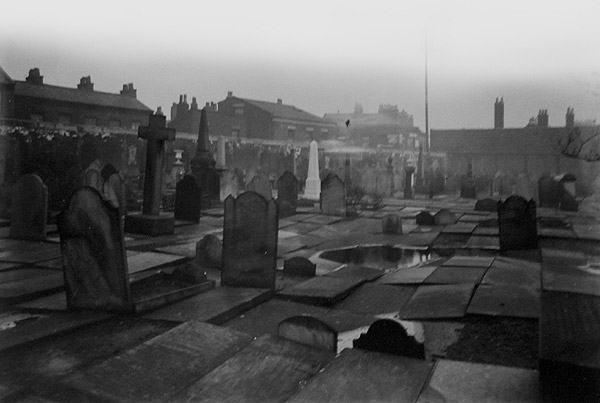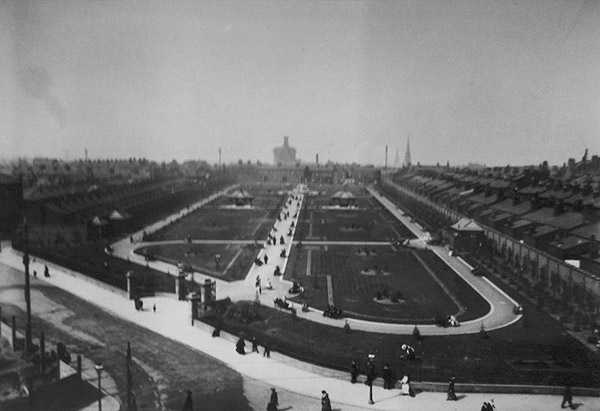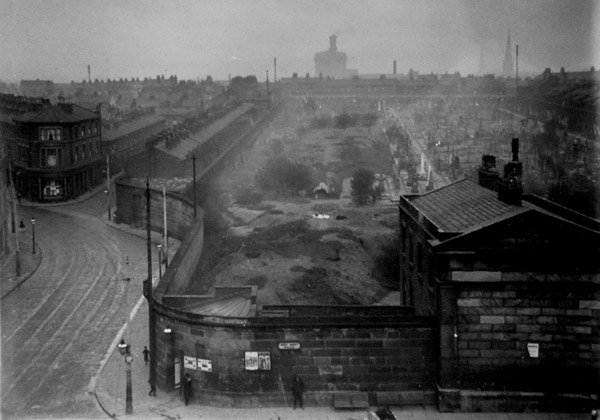
| HOME |
| NERVE |
| REVIEWS |
| ARCHIVE |
| EVENTS |
| LINKS |
| ABOUT US |
| CONTRIBUTORS |
| BACK ISSUES |
| CONTACT US |
Back to index of Nerve 24 - Summer 2014
 |
What Lies Beneath
By Siobhan
Twomey
Photographs from the Liverpool Record Office
The green and open spaces in the city provide a welcome break from the relentless urban cliffs provided by street after street of buildings. Some are paved and furnished with seating areas, others are laid out as gardens. These spaces not only provide somewhere for people to relax and enjoy, but give the built environment a breathing space too, and an arena to accentuate the importance of certain buildings within the cityscape.
One such place in Liverpool is St John's Gardens, Haymarket. This small city park is laid out with paths, flower beds, trees, grass and features several memorial statues and monuments. It is surrounded by a set of neo-classical public buildings: the Liverpool World Museum (1851), Central Library (1860, rebuilt 1960, rebuilt 2013), Picton Reading Rooms (1879), The Walker Art Gallery (1877) and along the top of the park the imposing Grade 1 listed St Georges Hall (1841-1854). As a municipal group, these buildings provided public access to history, knowledge, art and a palace of entertainment and justice.
When these monumental buildings appeared in the mid to late 19th century, the site of the gardens was occupied by St John's Church and surrounded by a well-stocked graveyard, including the graves of captured Napoleonic sailors along with local Liverpudlians, important and poor, but all levelled in death. The innovative ventilation system incorporated into St George's Hall was expressly designed not to have any ventilation inlets on the elevation adjoining St John's Church for fear of fouling the air with the unhealthy miasma emanating from the graveyard.
 |
This fear of breathing in unknown and possibly deadly air from putrid earth around burial grounds triggered changing attitudes to burial grounds within the city. The issue had already been much debated in Paris since the late 18th century, with the result that city burial grounds were closed in favour of parish burial grounds located further away from the consecrated church graveyards. Père Lechaise Cemetery, opened in 1804, was laid out as a park cemetery and changed attitudes to burial sites. A new dignity in death surrounded by nature was established, and it became a recreational pilgrimage to visit and memorialise loved ones. The American garden cemetery was much influenced by the hilly landscaped and tree-lined avenues, the personal burial spaces and the architectural tombstones and vaults that characterised Père Lachaise Cemetery.
At the start of the 19th century in Liverpool, there were ten graveyards within the confines of the town, with a growing population of 77,000 inhabitants. The oldest, the Church of St Nicholas (commonly known as the Sailor's Church) dated back to the 13th century, and was recorded as a burial ground in 1361 as a result of an outbreak of the plague. The other church graveyards date mainly from the 18th century, such as St Georges Church, Derby Square (now the site of the Victoria Monument), St Peters Church on Church Street (now shop and commercial buildings), St Paul's Church (now St Paul's Square) and St Peter's RC Church, Seel Street (a restaurant and late night bar).
The consequences of Liverpool's expanding dock system and subsequent urban growth sent population figures rising ten-fold to reach over 700,000 citizens by the start of the 20th century. By 1850, there were over 30 burial grounds in the city. Liverpool Necropolis was the first private, non-denominational cemetery to be built in 1825, on the outskirts of the city. Designed by John Foster Junior, it comprised a flat, rectangular shaped site with an imposing and a somewhat austere Greek Revival facade of two temples, joined together to make monumental funerary entrance gates to the burial grounds at the start of West Derby Road.
 |
The question of the overcrowded conditions of the living and the dead in UK cities was addressed by a series of Burial Acts, dating from 1852, which saw the end for city burial grounds by reason of protection of Public Health. In this city, they were all closed for interment within the next five decades by Order of Liverpool Corporation. A closure order meant that the land would be compulsorily purchased, all tombstone inscriptions would be recorded, and recently buried and requested remains would be exhumed and re-interred in the new outlying city cemeteries such as Toxteth, Anfield, Kirkdale and Allerton.
The Necropolis had been a very successful burial ground, but by the end of the century had become a particular cause for concern, with a report by the City Medical Officer in January 1896 about the 'putrescent matter lying beneath'. In 1889, workers re-laying the sewer pipe on West Derby Road reported coming across 'a large quantity of black jelly' adhering to the sewer nearest the Necropolis which emitted a frightful stench on being disturbed. By the time the cemetery was closed for interments in August 1898, a staggering 83,062 people (not including stillborns) had been buried in these confined grounds. After a respectful time of 15 years, the Necropolis was demolished by Liverpool Corporation to make way for road widening and newly laid-out public gardens.
While St John's Gardens and St Nicholas Gardens still can be enjoyed as city centre relaxation spaces, not all cemeteries were retained as green spaces. The economic value of a site meant the commercial potential of a site such as St Peters on Church Street meant that the only reminders that a church and burial site existed on Church Street is actually the street name itself, along with a small brass cross spot in the pavement. As for the Necropolis, the site provides a well-worn path for local residents walking to and from the city. It is known as Grant Gardens, presently a non-descript patch of green space. Within the concrete and brick urban fabric of the area, it gives no clues as to its role as the final resting place to tens of thousands of souls.
Comments:
Comment left by Peter Gill on 19th July, 2014 at 13:27
Very interesting some body's were dugup not long ago while work was being done on low hill by grant gardens so there is some still there